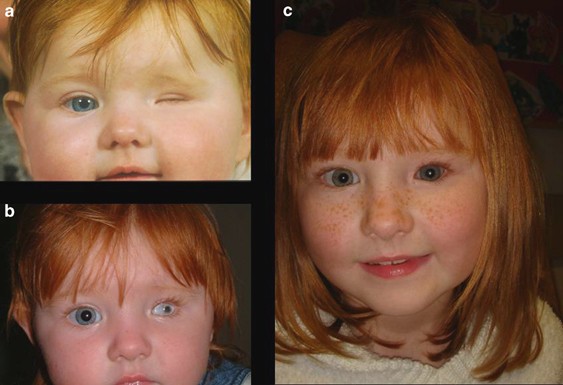10 rare congenital and genetic eye disorders
There are numerous uncommon inherited eye problems; these are just a few examples. These ailments differ from one another in their characteristics and prevalence. The 10 rare congenital and genetic eye disorders are:
Retinitis pigmentosa
It is a group of genetic disorders which occur due to genetic miscoding of proteins. These mutations affect the functioning of genes involved in the development and maintenance of the retina. In most cases, retinitis pigmentosa is inherited in a recessive or dominant pattern. It can also occur sporadically without a family history as a result of blunt trauma. The progressive vision loss occur from peripheral to central.
Its symptoms include night blindness, photophobia, tunnel vision, progressive vision loss and pigmentary changes. It occurs in 1 in 4,000 individuals worldwide.

Aniridia
Aniridia is a condition also known as “no iris”. In Aniridia, the patients present with abnormally enlarged pupil. The appearance of pupil is jet black. The iris (the part of eye which determines your eye color) is present but it is abnormally small and it or have an irregular shape.
It is caused by mutations in PAX6 gene. PAX6 is regarded as the main regulator of the eye, it is crucial for the development of the ocular system and CNS in vertebrates. Due to large size of pupil, it results in
- Poor vision due to lack of focus
- Increased sensitivity to light- the large pupil causes more light to enter the eye. The UV radiations of light are very damaging to retina
- Strabismus
The prevalence rate is approximately 1 in 50,000 to 1 in 100,000 individuals.

Optic nerve hypoplasia
It is the congenital anomaly of optic disc resulting in incomplete formation of optic nerve. The individuals with optic nerve hypoplasia may exhibit a range of visual impairments, depending upon the severity of the condition. The common symptoms of optic nerve hypoplasia are:
- Reduced visual acuity
- Visual field defects
- Strabismus
- Nystagmus
The National Organization of Rare Diseases estimates that 1 in 10,000 children are affected by this condition.

Anophthalmia
A severe form of congenital ocular defect known as anophthalmia is the total absence of one or both eye. Although the exact cause of anophthalmia is unknown, it is believed to include both genetic and environmental factors. It can also be associated with
- Fetal alcohol consumption
- Toxoplasmosis
- Rubella
- Herpes simplex
- HIV
- Cytomegalovirus
The infections from such viruses result in mutations of some genes which result in abnormal development of ocular structures.
Microphthalmia
It is also one of the rare developmental eye condition in which one or both the eyes are abnormally small. Its proper cause is unknown but it is considered that it is caused by abnormal development of optic vesicles and anterior neural tube during fetal development.
Diagnosis the diagnosis is done by
- Ultrasound
- CT scan
- Genetic testing
Chromosomal abnormalities, such as Patau syndrome, mosaic trisomy 9, 13q deletion syndrome, and Wolf-Hirschhorn syndrome etc. are the genetic causes of microphthalmia. According to researchers, in the United States, one in every 5,200 babies is born with anophthalmia or microphthalmia.

Coloboma
It is also one of the certain eye conditions in which one of the part of eye is missing. It can be unilateral or bilateral. It is of different types depending upon different vital parts of the eye. The coloboma can be present in iris, lens, uvea, retina, macula and optic nerve. This rare congenital disorders occur due to genetic causes.
People with coloboma are more likely to develop other issues of eyes e.g. retinal detachment, glaucoma and cataract. According to estimates, this disease affects somewhere between 1 in 5,000 and 1 in 10,000 live births. It’s crucial to remember that the prevalence might greatly change depending on the type of coloboma and the community under study.

Grave’s eye disease
It is also known as thyroid eye disease. It is an autoimmune inflammatory disorder. Its underlying cause is not exactly known. In a specific auto-immune reaction, IgG antibodies produce changes which result in enlargement of extra-ocular muscles and they become firm. This results in exophthalmos and papilledema. Its ocular signs include retraction of upper eyelid, infrequent blinking, protruding of eyeball (exophthalmia) resulting in photophobia, lacrimation, keratitis and corneal ulcers.
Its investigation include tests for hyperthyroidism, CT scan and MRI. It is expected to affect 2.9 per 100,000 men and 16 per 100,000 women in the general population.

Bietti’s Crystalline Dystrophy
Bietti crystalline dystrophy is a genetic disease in which there is build up of crystals in cornea. This leads to visual field constriction. The crystals are composed of fatty acids. Cornea is a transparent structure responsible for the entry and bending of light rays. The formation of crystals in cornea result in difficult in blurring of vision.
For BCD, there is presently no effective treatment. Low vision makes it difficult to carry out daily chores, even with the aid of glasses, contact lenses, medication, or surgery. One in 67,000 persons are thought to have Bietti crystalline dystrophy, according to estimates. People of East Asian heritage, particularly those with Chinese and Japanese ancestry, are more likely to experience it.

Retinoblastoma
Retinoblastoma is a rare form of eye cancer caused by genetic mutations in the cells of the retina, typically involving the RB1 gene. It is the most common intra-ocular tumor of childhood. It accounts for almost 3 percent of childhood cancers. It may be heritable or non-heritable. It can metastasize to the bones. Its symptoms are leukocoria, defective vision, strabismus, secondary glaucoma and proptosis. Its treatment depends upon the type of the tumor. Generally, it is treated with the help of following procedures if optic nerve is not involved.
- Chemotherapy
- Photocoagulation
- Cryotherapy
- Brachytherapy
- External beam radiotherapy
- Laser thermotherapy

Norrie disease
Norrie-Warburg syndrome, is a rare genetic disorder that primarily affects the eyes and can cause hearing loss as well. It is named after the British ophthalmologist Gordon Norrie, who first described the condition. Individuals with Norrie disease typically experience early-onset blindness or severe visual impairment.
Other eye abnormalities associated with Norrie disease may include retinal detachments, cataracts, and abnormal blood vessel growth in the retina. There is currently no cure for Norrie disease, but genetic counseling is recommended for families affected by Norrie disease to understand the inheritance pattern and assess the risk of passing the condition to future generations. More than 400 instances of Norrie disease have been reported, yet its frequency and prevalence rates are unclear.
Founder of EyesMatterMost- an optometry student who loves talking about eyes. I tend to cover topics related to optometry, ophthalmology, eye health, eyecare, eye cosmetics and everything in between. This website is a medium to educate my readers everything related to eyes.

